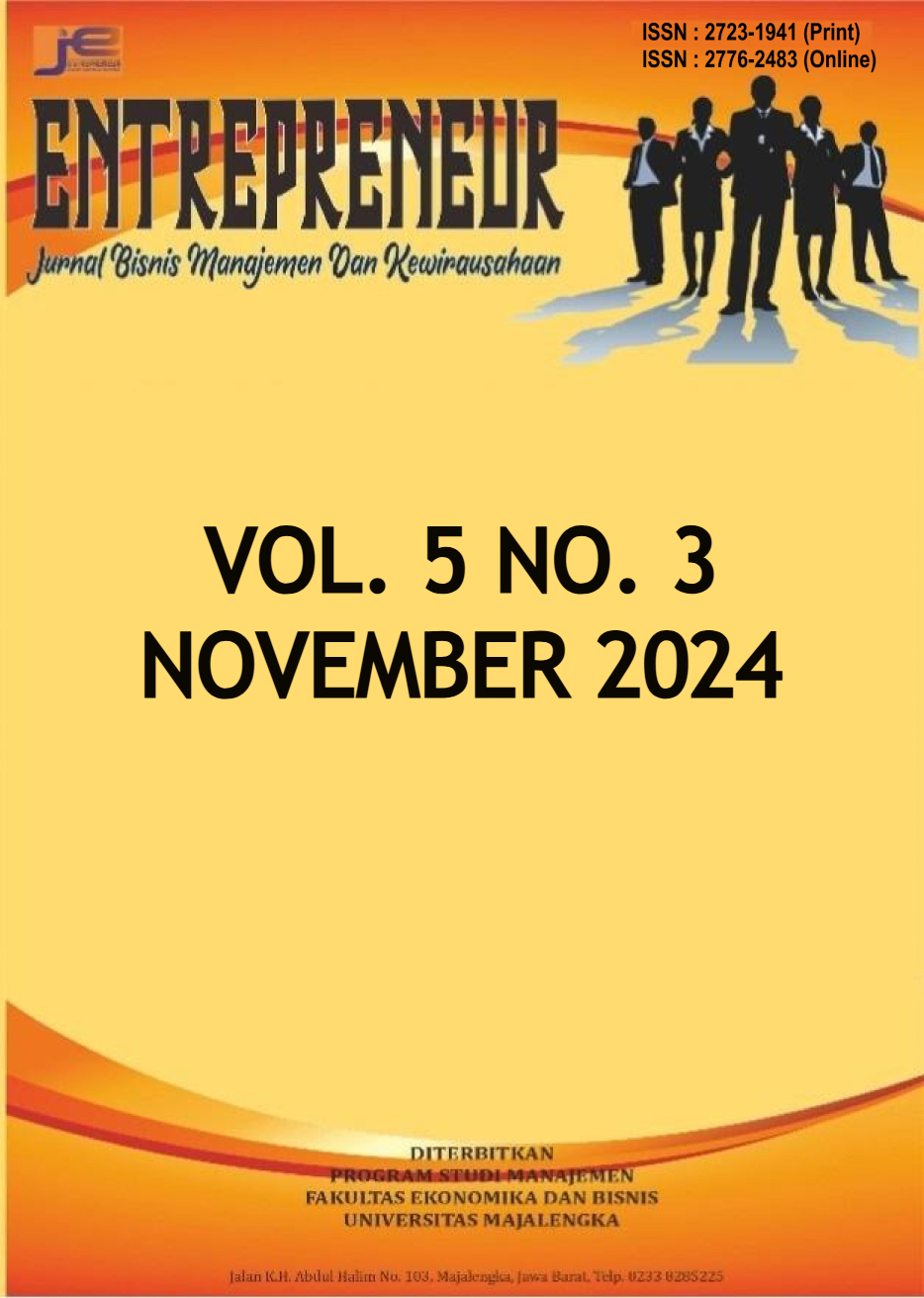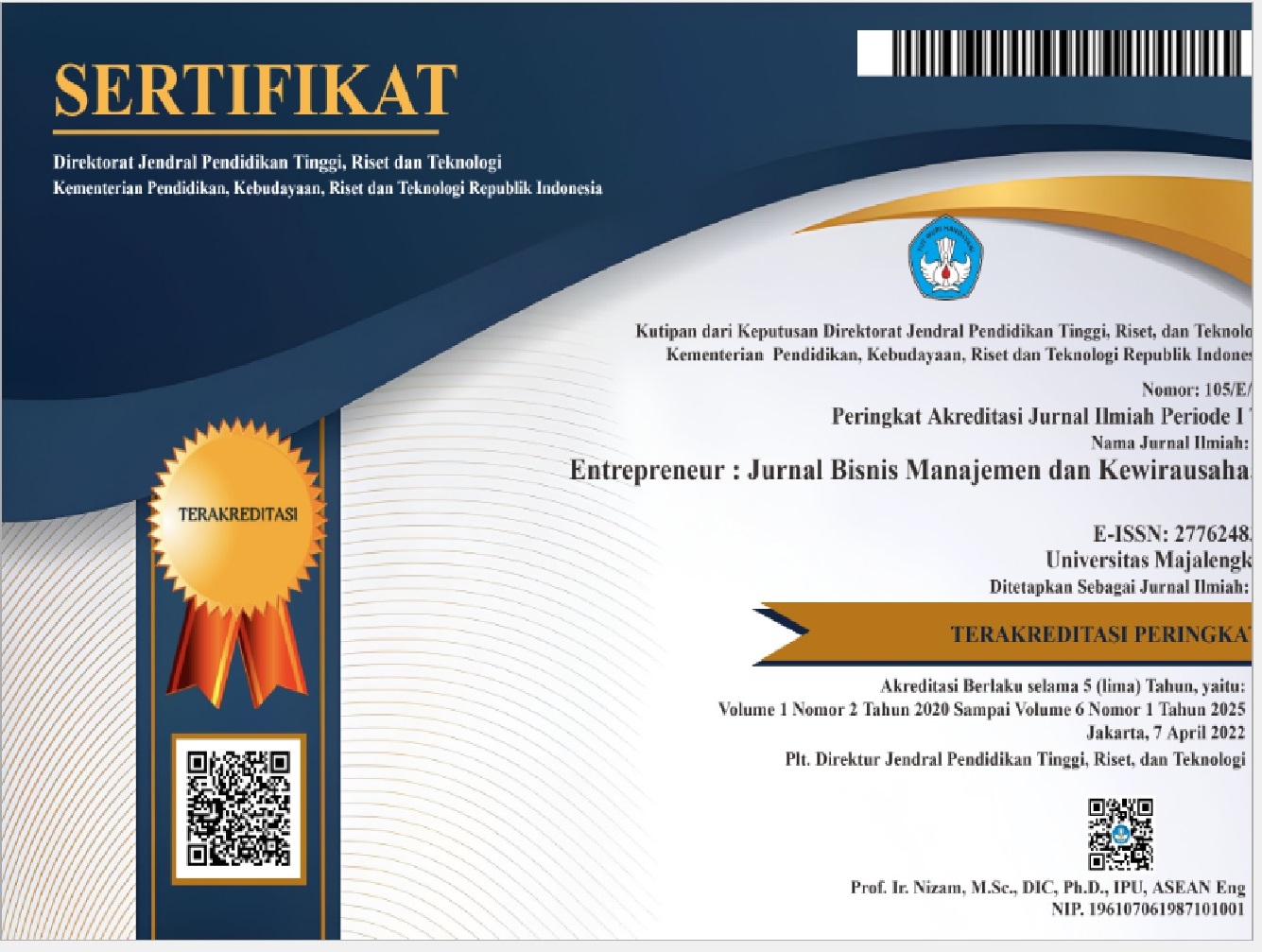Analisis Kapabilitas Pemasaran Dan Orientasi Pasar Terhadap Keunggulan Daya Saing UMKM Seketeng
DOI:
https://doi.org/10.31949/entrepreneur.v5i3.11374Abstract
Marketing capability as the ability to use inputs and resources, such as financial resources and existing customer bases to be used more efficiently in generating desired sales. Micro, Small and Medium Enterprises that are market-oriented and have marketing capabilities are needed to achieve marketing performance and competitive advantage. The purpose of this study was to analyze marketing capabilities, market orientation towards the competitive advantage of Micro, Small and Medium Enterprises in Seketeng Village, Sumbawa Regency. The research method uses a quantitative descriptive approach. The data analysis technique in this study uses the Statistical Package for the Social Sciences analysis. The results of the study indicate that Marketing Capability and Market Orientation simultaneously or together have a significant influence on the Competitive Advantage of Micro, Small and Medium Enterprises in Seketeng Village with a significance level of 5% (0.05) and F = (k; n-k) = f (2; 68) = 3.13. So that the Ftable value is obtained of 3.13 because the Fcount value> Ftable (24,915> 3.13). To improve the productivity of MSMEs in Seketeng Village, Sumbawa Regency, it is important to highlight the ability of marketing capabilities and market orientation in improving MSME marketing performance. MSMEs that have better marketing capabilities and use digital channels to promote their products or services tend to perform better in terms of sales growth, customer acquisition, customer retention and customer satisfaction. In addition, marketing capabilities play an important role in improving the competitive advantage of MSMEs. MSMEs need marketing capabilities to build sustainable competitive advantages because marketing capabilities create valuable intangible assets, such as rare and difficult-to-imitate knowledge.
Keywords:
marketing capability, market orientation, competitive advantageDownloads
References
Agyapong, A., Osei, H. V., & Akomea, S. Y. (2015). Marketing capability, competitive strategies and performance of micro and small family businesses in ghana. Journal of Developmental Entrepreneurship, 20(4), 1–25.
Da Costa, J. C. N., Camargo, S. M., Machado Toaldo, A. M., & Didonet, S. R. (2018). The role of marketing capabilities, absorptive capacity, and innovation performance. Marketing Intelligence and Planning, 36(4), 410– 424.
Fidela, A., Pratama, A., & Nursyamsiah, T. (2020). Pengembangan Usaha Mikro Kecil dan Menengah (UMKM) dengan Program Pemasaran Desa Jambu Raya di Desa Jambu , Kabupaten Sumedang. Jurnal Pusat Inovasi Masyarakat, 2(3), 493–498.
Frans Sudirjo, Arief Yanto Rukmana, Hilarius Wandan, & Muhammad Lukman Hakim. (2023). Pengaruh Kapabilitas Pemasaran, Digital Marketing Dalam Meningkatkan Kinerja Pemasaran UMKM Di Jawa Barat. Jurnal Bisnisman : Riset Bisnis Dan Manajemen, 5(1), 55–69. https://doi.org/10.52005/bisnisman.v5i1.134
Frans Sudirjo, A. Y. (2023). Pengaruh Kapabilitas Pemasaran, Pemasaran Digital Dalam Meningkatkan Kinerja Pemasaran UMKM di Jawa Barat. Vol. 5 No. 1.
Hudiyono, R. F. (2022). Analisis Program Pengembangan Usaha Mikro, Kecil, Danmenengah (Umkm) Oleh Pt Lima Pondasi Bersama. Jurnal Administrasi Bisnis Terapan, 4(2). https://doi.org/10.7454/jabt.v4i2.1026
Liliani, L., & Wiliana, J. (2018). Kapabilitas Dinamis UMKM dalam Merespons Perubahan Lingkungan Bisnis. Business and Finance Journal, 3(1), 33–46. https://doi.org/10.33086/bfj.v3i1.417
Liu, G., Eng, T., & Takeda, S. (2015). An investigation of marketing capabilities and social enterprise performance in the UK and Japan. Entrepreneurship Theory and Practice, 39(2), 267–298.
Lubis, Khairul Akhir. 2008. Pengaruh Pelatihan dan Motivasi Kerja terhadap Kinerja Karyawan pada PT. Perkebunan Nusantara IV. Tesis. Medan: Sekolah Pascasarjana Universitas Sumatera Utara, Medan.
Moeljadi. 2005. “Pengaruh Kekuatan Bersaing terhadap Kinerja Perusahaan Berdasarkan Pendekatan Balanced Scorecard”. Jurnal Ekonomi dan Manajemen, Volume 6 Nomor 3.
Mohammad Hoiron, E. W. (2018, Oktober). Pengaruh Kapabilitas Pemasaran, Keunggulan Bersaing dan Budaya Organisasi Terhadap Kinerja UKM (Usaha sKecil dan Menengah ) di Kabupaten Lumajang. Majalah Ilmiah (DIAN ILMU), Vol. 18 No. 1
Purnamasari, S., & Wijaya, A. (2020). Pengaruh Orientasi Pasar, Orientasi Kewirausahaan Dan Kemampuan Pemasaran, Terhadap Kinerja Bisnis Umkm Clothing Line. Business Management Journal, 16(1), 12. https://doi.org/10.30813/bmj.v16i1.2052
Riki Afriwan Wahyudi, E. K. (2023). Pengaruh Orientasi Pasar, Orientasi Kewirausahaan dan Inovasi Produk terhadap Kinerja Pemasaran pada Coffee Shop di Kota Padang. Jil. 22 No. 2.
Susilowati, Rini. 2005. Membangun Keunggulan Bersaing melalui Penataan Internal Rumah Sakit (Studi Kasus di Rumah Sakit Umum Daerah Ungaran). Tesis. Semarang: Program Studi Magister Managemen Program Pascasarjana Universitas Diponegoro.
Sugiyono. (2019). Metode Penelitian Kuantitatif Kualitatif dan R&D. Bandung: Alfabeta
Siregar, Baldric. (2017). Akuntansi Sektor Publik (Akuntansi keuangan Pemerintah Daerah Berbasis Akrual). Yogyakarta: UPP STIM YKPN
Sulistyawati, A. I., Indarto, & Saifudin. (2018). Beberapa Faktor yang Mempengaruhi Keunggulan Bersaing pada UMKM Handycraft di Semarang. Prosiding Seminar Nasional Unimus, 1, 307–315.
Wahyudin, N. (2015). Analisis Faktor-Faktor yang Mempengaruhi Keunggulan Bersaing untuk Meningkatkan Kinerja Pergutuan Tinggi (PTS) pada Sekolah Tinggi dan Akademi di Semarang. Holistic Journal of Management Research, 3(2), 77–93. https://doi.org/10.13140/RG.2.2.23258.64961

Published
How to Cite
Issue
Section
License
Copyright (c) 2024 Sri Rahayu, I Putu Gede Diatmika

This work is licensed under a Creative Commons Attribution-ShareAlike 4.0 International License.
COPYRIGHT NOTICE
An author who publishes in the Entrepreneur: Jurnal Bisnis Manajemen dan Kewirausahaan agrees to the following terms:
1. Author retains the copyright and grants the journal the right of first publication of the work simultaneously licensed under the Creative Commons Attribution-ShareAlike 4.0 License that allows others to share the work with an acknowledgment of the work's authorship and initial publication in this journal
2. The author is able to enter into separate, additional contractual arrangements for the non-exclusive distribution of the journal's published version of the work (e.g., post it to an institutional repository or publish it in a book) with the acknowledgment of its initial publication in this journal.
3. The author is permitted and encouraged to post his/her work online (e.g., in institutional repositories or on their website) prior to and during the submission process, as it can lead to productive exchanges, as well as earlier and greater citation of the published work







